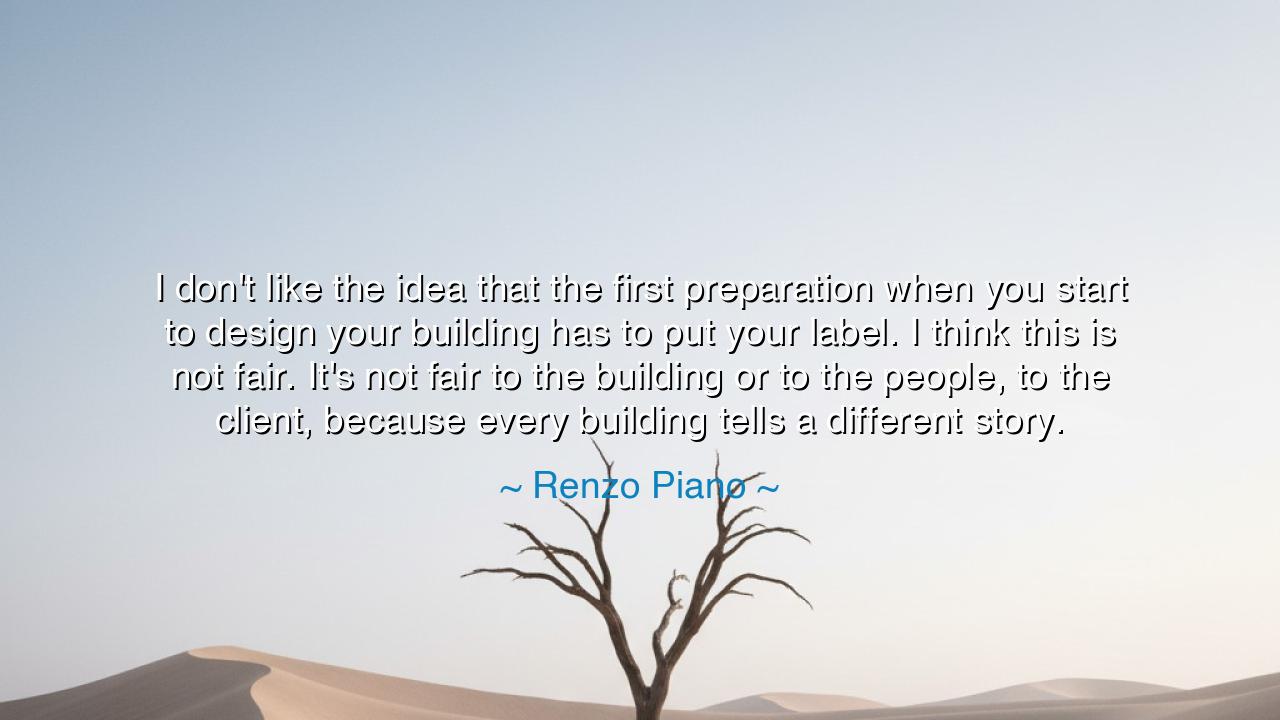
I don't like the idea that the first preparation when you start
I don't like the idea that the first preparation when you start to design your building has to put your label. I think this is not fair. It's not fair to the building or to the people, to the client, because every building tells a different story.






“I don't like the idea that the first preparation when you start to design your building has to put your label. I think this is not fair. It's not fair to the building or to the people, to the client, because every building tells a different story.” Thus spoke Renzo Piano, the master architect whose works breathe with the lightness of wind and the warmth of human touch. In this reflection, he offers not merely a commentary on architecture, but a philosophy of creation, humility, and listening. For in his words lies a rebuke to the arrogance that too often infects the act of design—the pride that seeks to brand before it seeks to understand. Piano reminds us that the true creator does not impose form upon the world, but discovers the form that already wishes to be born.
To “put your label” upon a building before its conception is, in Piano’s eyes, to commit a kind of spiritual violence. It is to make the work serve the ego of the maker rather than the needs of the people or the nature of the place. The label—the signature style, the predictable mark of authorship—is an act of possession, not of love. But a building, he says, is not a product of ownership; it is a living dialogue between the land, the client, and the human spirit. To force one’s identity upon it is to silence its own voice. The true artist must approach creation not as a conqueror, but as a listener—an interpreter of context, history, and human need.
Piano’s own life gives meaning to his words. From the Centre Pompidou in Paris to The Shard in London, from museums in Texas to harbors in Genoa, his works are as diverse as the places they inhabit. No two look alike; no single style defines them. And yet all are unmistakably his—not because they bear his “label,” but because they reflect his philosophy of empathy. When he designed the Menil Collection in Houston, he studied the soft Texas light and created a roof that filtered it like the leaves of a tree. When he built the Kansai Airport in Japan, he studied the winds of the bay and shaped the terminal like a bird in flight. Each building, he believed, must tell its own story, shaped by the soul of its surroundings. This is the humility of the true craftsman: to serve the story, not the self.
The ancients, too, would have understood this wisdom. Consider the builders of Gothic cathedrals, who labored in anonymity, never carving their names into the stones they raised toward heaven. Their art was not theirs alone; it was the work of centuries, of faith, of community. They did not brand their cathedrals; they served them, allowing the divine light to pass through stained glass, the voices of the faithful to echo through vaulted space. Theirs was an architecture of devotion, not of vanity. So too does Piano call upon us to rediscover this sacred humility—to remember that the act of creation is not about the glorification of the maker, but the glorification of life itself.
In modern times, many creators—architects, artists, and thinkers alike—have fallen into the trap of the “label.” They repeat themselves, mistaking consistency for genius, style for substance. The market rewards this; fame demands it. But Piano’s words rise as a warning: the moment you design for your own signature, you cease to design for truth. Every building, every project, every endeavor must begin not with self-expression, but with observation. To create authentically is to listen first—to the materials, the climate, the people who will dwell within what you make. The work that comes from listening will endure; the work that comes from pride will one day crumble.
There is also a deeper moral resonance in Piano’s philosophy, one that extends far beyond architecture. Each human being, he reminds us, must approach life itself as a designer approaches a building—with openness, curiosity, and compassion. We must resist the temptation to label others, to force them into the shape of our own assumptions. Every person, like every building, has a story of their own—a history, a rhythm, a light that is uniquely theirs. To judge too quickly, to impose our expectations upon them, is to dishonor the individuality of their design. The wise live as Piano builds—with attentive respect for the story unfolding before them.
Thus, the lesson of Renzo Piano is both artistic and spiritual: create without ego, observe before you shape, and serve before you claim. Let your work, whatever form it takes, be a reflection not of your vanity, but of your reverence for the world. Approach each task as a new beginning, free from the weight of your past triumphs or the shadow of your reputation. For only then will your creation live, breathe, and speak with authenticity.
And so, dear listener, remember this truth: the greatest creations do not shout their maker’s name—they whisper the stories of others. They are born not from pride, but from care; not from formula, but from faith. In every design, whether it be a building, a friendship, or a life itself, let the world’s voice guide your hand. For in doing so, you will become not merely a creator, but a partner in the poetry of existence, joining the eternal chorus of those who build with love, humility, and the wisdom to listen before they leave their mark.






AAdministratorAdministrator
Welcome, honored guests. Please leave a comment, we will respond soon